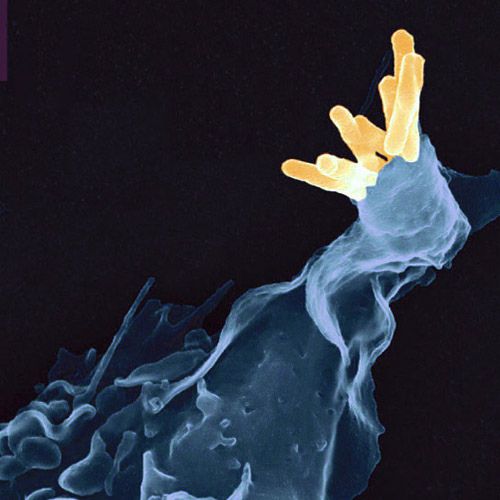-
 Procellariiformes
Procellariiformes
-
 Parabens
Parabens
-
 Neurotransmitter
Neurotransmitter
-
 Malacology
Malacology
-
 Boson
Boson
-
 Data link
Data link
-
 MA
MA
-
 Exergonic
Exergonic
-
 Lore
Lore
-
 Flavour
Flavour
-
 Kepler's first law
Kepler's first law
-
 Genetics
Genetics
-
 ROT-13
ROT-13
-
 Wood energy
Wood energy
-
 Ozone
Ozone
-
 Continental crust
Continental crust
-
 Rolling mill
Rolling mill
-
 Autologous
Autologous
-
 Cyst
Cyst
-
 Prognosis
Prognosis
-
 Gastrin
Gastrin
-
 Extended area
Extended area
-
 Eccentric
Eccentric
-
 Scaly
Scaly
-
 Esker
Esker
-
 Theorem
Theorem
-
 Multiple access
Multiple access
-
 Compound eye
Compound eye
-
 Bird of prey
Bird of prey
-
 Polar body
Polar body
Koch Bacillus
The Koch Bacillus (Mycobacterium tuberculosis) is the agent which causes tuberculosis.
Features of the Koch bacillus
The Koch bacillus was discovered by Robert Koch in 1882 and was entirely sequenced in 1998.
Although it is not permeable to Gram staining (because of its external waxy layer), these bacteria are netherless deemed to belong to the Gram positive group as they have no external membrane.
The bacterium is rod-shaped and contains a circular chromosome with more than four million base pairs coding approximately 4,000 genes.
Koch bacillus and tuberculosis
The bacillus infects the respiratory tract where it causes the symptoms of tuberculosis. Although research is progressing, not all the virulence factors have been clearly established. They appear to be a set of factors and not a single one.
The bacillus may also hide in adipose cells where it is shielded from antibiotics. It can then re-emerge in patients who seemed to have been cured.
 The Koch bacilli can be phagocytosed by immune cells. © AJC1, Flickr, CC by-nc 2.0
The Koch bacilli can be phagocytosed by immune cells. © AJC1, Flickr, CC by-nc 2.0
Latest
Fill out my online form.



